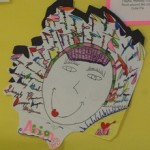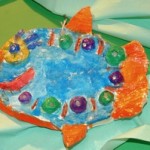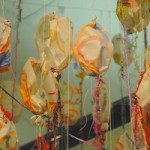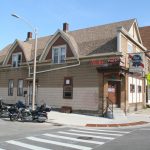Arts education is not a waste of time

Community artists and students created the art plaques that grace the outside walls of Elm Creative School.
“When I was nine and I asked my dad, ‘Can I have your movie camera? And I took it and I started making movies with it and I started being as creative as I could, and never once in my life did my parents ever say, “What you’re doing is a waste of time.” Never. And I grew up, I had teachers, I had colleagues, I had people that I worked with all through my life who always told me what you’re doing is not a waste of time,” – Michael Giacchino, 2010 Oscar winner for Best Musical Score for “Up”
Art. Music. Theater. Dance. These are all endeavors that add color, movement, sound and thought-provoking performances to our lives. As we finish up the annual awards season honoring the best in entertainment, these very outlets of creativity are under fire in our schools.
Due to funding inequities and increased benefit costs, arts and music courses, along with physical education, are being cut or eliminated from schools. Elm Creative Arts Elementary School and every other school in MPS is under attack, but the parents, teachers and students at Elm refuse to take the loss of art teachers lying down.
Last week, Milwaukee Public School administration announced that economic woes facing the district would force the elimination of 30 art teachers, 46 music teachers, 40 gym teachers, 7.5 language teachers and 12 librarians.
Elm is one of five MPS schools that integrate arts into the entire curriculum. Every staff member and teacher has a minor in art in addition to an education degree. The school boasts a full-size dance studio, a fully functioning theater and professional grade music rooms. It’s the school you want your children to attend. It’s bright, colorful and welcoming. The teachers are caring and warm. The kids seem excited to learn and everyone, from staff to the parents, is heavily involved with the school.
The ever-changing art gallery is the first thing students and visitors see upon entering the building on West Walnut Street. Many visitors come from around the nation to learn from how art, music, theater and dance can be successfully used to teach math, reading, history and science. In addition to classroom studies, every student has a weekly art, music, dance and theater class, often lead by an artist-in-residence from the community.
“This isn’t just art for art’s sake,” says Christina Ratatori, an Elm dance teacher and chairperson of a.r.t. (artists. rallying. together). “This is learning academics through art. How did you learn your ABCs? With a song. We use songs to tell time. We have a song and dance to learn the continents.”
Another example of integrating arts into the classroom involved a field trip to a production of First Stage Theater’s The Thief Lord. After attending the show students read the play, chose a character and studied it in depth, then decided what the character would take on a trip. From there, they designed a suitcase to help visualize it and wrote a story describing the trip. Reading, writing, research, creative thought, and art – all derived from a field trip to a play.
Success at Elm can be found in the everyday victories. Ratatori cited examples like problems on the playground being solved in a tap dance class. Or the light bulb that goes on in the brain of the ADHD child in music class. And even the student who is able to stand before the Milwaukee Public School board and share why his school is important.
But for those who want strict academic proof that arts education has benefits, look at the test scores. In 2008 (the latest scores available from the Wisconsin Department of Instruction) fourth graders at Elm had higher percentages of proficient and advanced scores in math, reading, language arts, science and social studies than MPS or the state as a whole.

Art and writing blend into one lesson at Elm Creative School. These masking tape dolls were inspired by the work of Milwaukee artist Andrea Skyberg.
Public opinion and professional studies have also shown that arts are essential for a well-rounded educational experience. According to a 2005 Harris Poll, 86 percent of Americans agree that arts education assists in the improvement of a child’s attitude toward school, and 83 percent believe it can teach children to communicate effectively with adults and peers.
A look at SAT scores from 2005 shows a marked difference between those students who had arts education and those who did not. Those who had four or more years of arts scored an average score of 534 on the verbal portion of the test and 540 on math, compared to students with a half-year or less, who averaged 485 verbal score and 502 in math. And a national study of 25,000 middle and high school students found that those with high arts involvement performed better on standardized state achievement tests, watched fewer hours of television, had higher hours of community service involvement and reported less boredom in school.
These are the qualities and results we all want from our students. These are the qualities and results the No Child Left Behind standards require. These are the qualities and results that are happening right now at Elm Creative Arts Elementary School.
So why are we so reluctant to change how we fund and support the arts when they have been proven to improve student achievement? Why are we so reluctant to close failing schools or schools that are underutilized in the name of “neighborhood schools” and antiquidated benefit schedules? There are no easy answers, but maybe there are some fresh perspectives out there.
- Even practicing cursive writing can be an artistic endeavor.
- Ceramic fish swim through the Elm Creative School art gallery.
- Elm K-5 students visualize their homes in clay
- Paper balloons take on a jellyfish quality suspended from the school’s gallery ceiling.
- Art and writing blend into one lesson at Elm Creative School. These masking tape dolls were inspired by the work of Milwaukee artist Andrea Skyberg.
- Community artists and students created the art plaques that grace the outside walls of Elm Creative School.




























